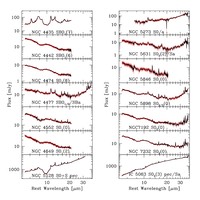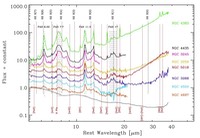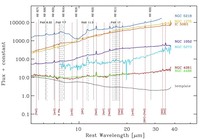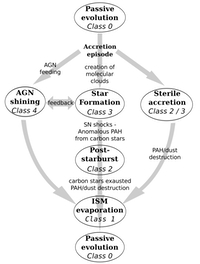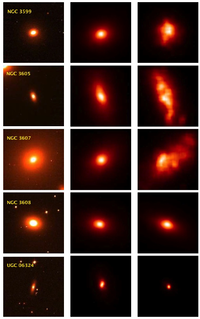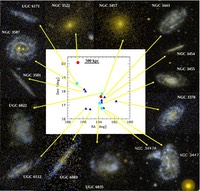My research field
Interaction, accretion and merging events along the Hubble time play a key role in determining the overall galaxies properties. Several studies suggest that such events are well effective not only in clusters but also in the poor galaxy aggregates of low density environments (LDE). Provided that typical galaxy aggregates in LDE, such as groups, today contain a substantial fraction of the mass of the Universe, this implies that the local environment strongly affects the evolution of most galaxies.
In this context very poor galaxy aggregates and nearly isolated galaxies, in particular early-type galaxies (ETGs) deserve a special value. The former class includes the simplest systems where the effect of the ongoing interaction on the galaxy evolution can be directly tested, while ETGs are widely considered the fossil evidence of the process of galaxy evolution.
We adopt the so called archeological approach, i.e the subject of our investigations are nearby objects, where multi-wavelength studies of single galaxies, of the groups structure and of the inter-galactic medium (IGM) can be performed with an unprecedented detail exploiting the new generation of telescopes and instruments.
A Far UV view of ETGs
GALEX FUV (blue) and NUV (yellow) color-composite images of the galaxy members of LGG 225 and their spatial distribution on the sky (red circles: ellipticals; blue triangles: spirals; cyan pentagons: irregulars). Note the two strongly interacting galaxies NGC 3447 and NGC 3447A. A bar is still visible in NGC 3447 while both the underlying disk and the multiple arms are tidally distorted. The sites of recent and on-going star formation, including a knotty ring around NGC 3447, are unambiguously detected in UV. Most galaxies show signatures of morphological distortion and asymmetries. Are the evolution of groups dominated by late-type galaxies linked to early-type rich and fossil groups ?
We use GALEX to investigate nearby early-type galaxies as relics of the evolution within groups. Our purpose is to investigate the co-evolution of groups, starting from groups similar to the Local Group of Galaxies, and of their members galaxies.
A far UV GALEX analysis of Shell Galaxies
A GALEX view of ETGs with ionized gas
Galaxy evolution in Local Group Analogs
Signature of recent star formation in ring S0 galaxies
A UV-optical/kinematical view of galaxy evolution in the Leo Cloud
NGC 3934: a shell galaxy in a compact environment
Multi-wavelength investigation of poor groups
Is the evolutionary path of poor galaxy structures leading from very poor galaxy groups to isolated giant elliptical galaxies, e.g. are E+S physical pairs a way station towards an isolated E? Can this evolution be guessed from the properties of ETGs located in these systems? What have been the main drivers of the evolution observed in groups ETGs ?
Evolved groups (page 1)(page 2)
Galaxy evolution in E+S systems
An ongoing project: Tracing the transition from active to passive galaxy groups
Nearby ETGs with ionized gas in LDE:
an optical and Mid Infrared view
Although, ETGs appear as a uniform class of galaxies, populating a planar distribution (the so-called Fundamental Plane) in the logarithmic parameter space defined by the central stellar velocity dispersion, the effective radius and effective surface brightness (see e.g. Djorgovski & Davis 1987), much evidence suggests that a secondary episode of star formation has occurred during their evolutionary history. Simulations indicate that galaxy collisions, accretion and merging episodes are important factors in the evolution of galaxy shapes (see e.g. Barnes 1996; Schweizer 1996) and can interfere with their passive evolution. This understanding of ETG formation has been enhanced by the study of interstellar matter. This component and its relevance in secular galactic evolution was widely neglected in early studies of early-type galaxies since they were for a long time considered to be essentially devoid of interstellar gas. In the last two decades, however, multi-wavelength observations have changed this picture and have detected the presence of a multi-phase Inter Stellar Medium (ISM): a hot (~107 K) and a warm (104 K) phase coexist and possibly interplay in several giant ellipticals. A cool (~10 K) phase, detected in HI and CO, is also often revealed in early-type galaxies (Bettoni et al. 2001 and reference therein). Unlike spiral galaxies, the bulk of the gas in ellipticals is heated to the virial temperature, emitting in X-rays, and only comparatively small quantities are detected in the warm and cool phase of the interstellar medium (Bregman et al. 1992). The amount of X-ray emitting gas is related to the optical luminosity of the galaxy (White & Sarazin 1991), while no relation is found between the properties of the other components and the galaxy stellar luminosity. This latter fact may indicate that some amount of the gaseous material may indeed be of external origin. A pioneering spectroscopic study (Phillips et al. 1986), that examined the properties of a set of 203 southern E and S0 galaxies, began to shed light on the physical condition of the ionized gas in early-type galaxies. On the grounds of their analysis of the [NII 6583]/Ha ratio they pointed out that, when line emission is present, it is confined to the nucleus and the properties of giant ellipticals are ``indistinguishable'' from a LINER nucleus (Heckman 1980).
Despite the large number of studies both the ETGs star formation history and the gas origin and ionizing mechanisms are still matter of debate. We are approaching this subject through a multi-vavelength study of 65 nearby ETGs (Vhel < 5000 km/s).
Stellar populations in ETGs with emission lines at optical wavelengths.
Origin and powering mechanisms of the ionized gas
Mid Infrared view of ETGs with ionized gas
A Spitzer-IRS Spectroscopic Atlas of Early-Type galaxies in the RSA Catalog
X-ray view of ETGs and their environments
Shell galaxies represent the ideal class of ETGs through which to investigate the galaxy evolution in LDE for several reasons. A rich harvest of simulations performed since their discovery in early 80s, proposed two different scenarios to explain their origin. A weak interaction between galaxies can form long lasting azimuthally distributed shells through the interference of density waves produced in a thick disc population of dynamically cold stars. Since the above class of model requires a cold thick disc, it is generally believed that shells are generated through either minor or major merging events. In merging models, shells are density waves formed from infalling stars of the companion during the merger. Both weak interaction and merger models qualitatively reproduce the basic characteristics, such as spatial distribution, frequency and shape, of observed shell systems. Shells could not be maintained within clusters since continuous ``harassment'' between galaxies would destroy them. Shells galaxies avoid indeed the cluster environment and are found with a high frequency in the field. They represent ~16.5% of the ETGs population in the field suggesting that interaction/merging events have played a significant role in their formation/evolution.
XMM-Newton observations of shell galaxies
Hot gas in groups: the intriguing case of NGC 4756
Recent collaborations with italian Institutions
F. Annibali (INAF-OABo), A. Bressan (SISSA, Trieste), D. Bettoni, L.M. Buson, M. Clemens, M. Mapelli, P. Mazzei (INAF-OAPd), G. Galletta, A. Marino (Univ. Padova), G. Trinchieri, A. Wolter (INAF-OA-Brera), M. Uslenghi (IASF Milano).
Recent collaborations with Foreign Institutions
L. Bianchi (JHU, Baltimore, USA), P. Panuzzo (Observatoire, Paris-Meudon, France), H. Plana (LATO-UESC, Bahia, Brazil), M. Rosado (UNAM, Mexico DF, Mexico), J.W. Sulentic, L. Verdes-Montenegro (Dpto Astronomia Extragalactica, Granada, Spain), O. Vega (INAOE, Puebla, Mexico), W.W. Zeilinger (IfA, Univ. Wien, Austria).

